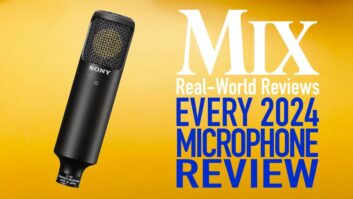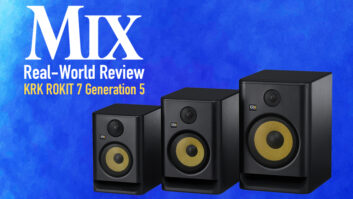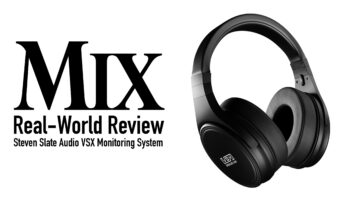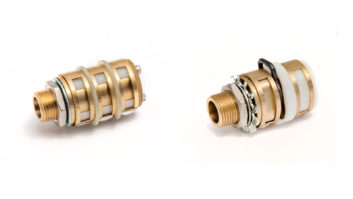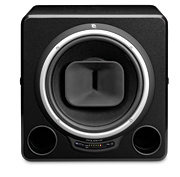
The Q15’s coaxial design helps focus stereo imaging and eliminate phase shift outside the sweet spot
As co-founder and past-president of Event Electronics for years before starting Equator Audio Research, Ted Keffalo knows a thing or two about speaker development. His search for clarity in Equator’s new monitor line took him outside of the typical near-field world and instead into coaxial designs. As a result, Keffalo and a team of engineers have developed the Q15, a two-way active monitoring system based on a custom coaxial design they call Zero-Point Reference: two drivers, one sonic point source.
Brawn With Brains
I reviewed Equator’s top-end Q15s, each weighing 92 pounds and sporting a 15-inch woofer and 1.5-inch HF compression driver, backed by 1,000-watt and 200W amplifiers. The side and back panel of the cabinet are ¾-inch 13-ply Baltic birch; the sculptured front baffle is 1-inch HDF (not MDF).
The Q15s have no preset crossover slopes; instead, they have continuously adjustable ones — an approach that Equator claims reduces the midrange distortion often associated with conventional co-ax designs. A CPU inside each monitor digitally controls the drivers, matching and time-correcting audio on all three axes — horizontal, vertical and depth.
Power On!
Each monitor has a rear USB port and two RS-485 ports for daisy-chaining. I connected the left speaker to my computer via USB, and from the left speaker I connected the right speaker using a standard Cat-5 cable. Eight DIP switches on each monitor let you set speaker ID and other parameters. The Q15s accommodate XLR and ¼-inch cables — balanced or unbalanced.
The Q15’s included management software let me make critical adjustments from the mix position instead of having to use controls built into the speaker, which typically force the user to leave the sweet spot. The proprietary Equator Control and Manual Room Response Compensation (RRC) applications are provided on disc for Mac OS 10.4 and Windows XP.
Beginning with the software’s System Config tab, I addressed the left-speaker stereo setup and then used the “Scan for Speakers” button to find the other’s unique speaker ID set with the DIP switches. A visual representation of your setup is shown at all times in the upper-half of the GUI, along with virtual solo, mute and select “switches” alongside each monitor icon. The software lets you create multiple listening configurations (“speaker groups”) that you can name for easy reference — e.g., “stereo mains,” “mains + sub,” “surround,” etc.
After I entered my room’s dimensions, Equator Control calculated primary room modes and instructed the monitors to correct for three standing waves (front-to-back wall, left-to-right wall and floor-to-ceiling), using three parametric filters with user-adjustable frequency, Q and gain. Changes to the bass response were immediately noticeable, alleviating a nagging 50Hz buildup problem. My room is outfitted with substantial bass trapping, so I pulled the default attenuation back by a few dB to best suit the room in its treated state. I also manually adjusted the center frequency of the second mode to a higher harmonic of itself because it was stronger and more problematic than the fundamental. A response graph displays for each speaker exactly what frequencies are being treated in the 20 to 300Hz range.
I entered each speaker’s relative location (“No Wall,” “Wall,” “Corner”), and the software compensated for boundary/placement anomalies. A phase-invert button is provided for each speaker, as well as a sensitivity gain control, and the optional Q18 subwoofer can be delayed to align with the satellites. This flexibility is a godsend for surround installs and for doing stereo mixes in nonsymmetrical rooms.
The process of room analysis and compensation becomes automated when used with the optional Q Series Calibration Kit ($495), even allowing for optimization at specified listening positions within a room, such as the engineer’s mix position, producer’s desk, band couch, etc. The kit — unavailable in time for this review — includes a calibration mic and Secondary Reflection Correction™ (SRC) software, which, according to Equator, can also correct for comb filtering and phase cancellation.
Listening Party
The technical features are impressive, but how do these sound? Fantastic! With their high (121dB) SPL capability and wide dynamic range, recording with the Q15s was nothing short of a blast. Players sat beside me at the board and recorded electric guitars and bass using DI boxes. They commented on how much more fun and inspiring it was to track to the loud vibe of the Q15s than on typical near-fields. The oversized bass ports displayed no audible chuffing effect, but ensured in-your-face sound and live excitement — a luxury that’s typically found in big rooms.
The low frequencies are pronounced, natural-sounding and not overstated, yet were exceptionally accurate on urban and club tracks, which often have many bass elements. Here, the Q15s clearly identified where each sound lived, as well as which sounds were trying to steal space.
The midrange was clear and concise, possibly attributable to the “no-slope crossover.” One song I mixed had three acoustic guitars, four electrics, two female counterpoint vocals and background harmonies. The Q15s made dynamics and EQ decisions on this midrange smorgasbord nearly effortless. I could easily differentiate between the subtlest attacks, balance and tame resonances, zero-in on conflicting tones and more. I never doubted the frequency range of a vocal or instrument, and could carve out my mix pockets more quickly. EQ problems in the tracks jumped out.
I expected that the Q15s would have wide high-frequency dispersion, yet the sweet spot was much larger than I could have anticipated — easily spanning my 8-foot desk. At first, I thought the highs were too pronounced, especially compared to my Mackie HR824s and even my ribbon-tweeter ADAM S3As. I concluded that the Q15s were flat, and I was likely just hearing a much better spectral balance from a single point source. Transients became more defined and frequency response was superior in both vertical and horizontal planes. The Q15’s high-frequency compression drivers are silky smooth and articulate, capable of pushing “air” to an altitude of 22 kHz. I used these speakers on many day-long sessions and showed no hint of fatigue.
I was surprised at how much more conservative — and confident — my panning became. With the Q15s, soundstage placement becomes highly defined, as though the available stereo space actually opens up on you. Similarly, I began making smaller and fewer gain changes overall as it became apparent which changes were truly necessary, and my edge for subtractive mixing really came back. The result is that the Qs make you mix “smarter” — not harder.
When I moved the Q15s into my 10×10-foot edit suite and placed them only three feet apart, they still provided exceptional imaging. Ultimately, the Q15s are a one-size-fits-all solution: ideal as near-fields, mids and mains.
Impressive
Hands-down, these are the best-sounding, best-performing monitors I’ve worked with. I’m convinced the coaxial design is best for a two-way system. The Q15s let me hear what’s right and what’s wrong so I could make quick judgment calls, and they offer the power of mains in the footprint of near-fields.
When I drove these incredibly hard, they sounded as good and spectrally balanced as they did at lower levels, and nothing I can think of comes close to the Q15’s pinpoint accuracy. You can turn your head, spin your chair around, stand up and lean over the board, and the image doesn’t shift.
Equator’s Q Series represents the state of the art in monitoring system design. For this level of sophistication, the price tag is about half of what it ought to be — a tremendous value.
Jason Scott Alexander is a producer/mixer/remixer in Ottawa, Canada.
PRODUCT SUMMARY
COMPANY: EQUATOR AUDIO RESEARCH
WEB: www.equatoraudio.com
PRODUCT: Q15 Monitors
PRICE: $3,000 each
SYSTEM REQUIREMENTS: Mac OS 10.4 and/or Windows XP
PROS: Sophisticated room-correction software run from Mac/PC. Pinpoint imaging, high SPL and great sound.
CONS: May be too heavy for many meter bridges. Power supply is internally set at the factory for designated voltages.



